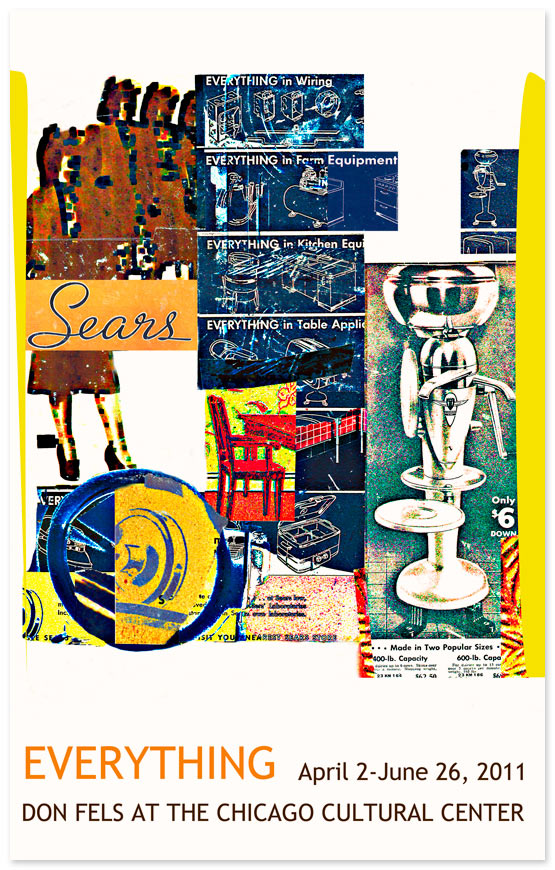
“Everything”
Chicago
“Kind friend: This big catalogue has been made so thoroughly complete in every department that it is intended to be used for ordering goods and for reference, season after season.” Introduction from the 1902 Sears, Roebuck catalogue, ‘the cheapest supply house on earth’.
In the first decades of the 20th century, Sears Roebuck and Co. was an enormous presence in the lives of Americans, especially in the country’s rural heartland. Based in Chicago, the company became a literal conduit of material wellbeing to families living on farms and in small towns and cities, supplying them with every imaginable product from the pages of the mammoth Sears catalogue.
For this exhibition at the Chicago Cultural Center, Fels employed vintage Sears catalogues and other materials, including the Encyclopedia Britannica, which Sears purchased, brought to Chicago and published, to create a series of layered collages about what the company delivered. The catalogs represented an enormous store; and yet for years the only connection to that store that customers had was through the pages of the ‘big book’. Each page was a window on a world.
Accompanying the collages was an installation on the projection of Sears into the world. In 1906, Sears produced a series of 50 stereo-views of the company at work, a very early ‘infomercial’ to inculcate people around the country on how massive and important was the Sears operation in Chicago. The company undertook this effort because they needed customers, often in the hinterlands, to understand that Sears was large and solvent, and that their orders were treated with modern efficiency.
Working with these images, railroad maps (Sears based itself in Chicago because it was at an important nexus of rail lines that the company could use to bring products into its warehouses and out to its customers), and images of once cutting-edge media players from the catalog (the company was very involved in marketing devices allowing people to view, photograph and film the world). Sears produced the 1906 stereo-views because they were popular parlor entertainment of the time, but the inherent 3-D spatiality of the media was also essential to the company’s message. Sears wanted people to see the company and its products as existing in actual corporeal space, not just as printed on thin catalog pages.
Much as the internet had to convince users it could be trusted to deliver real goods, Sears paved the way with its catalog a century earlier. Long before there were Sears stores or a Sears Tower, there was the catalog, with its hundreds of pages full of enticement. The visual images of those goods represented the real Sears stock in trade. Sears produced very little of what it sold- but the vision of a better life that it offered up to Americans was all theirs.
The Chicago Cultural Center convened a lively panel discussion about Fels’s take on Sears with Rod Slemmons, Director of Chicago’s Museum of Contemporary Photography, Tim Samuelson, Chicago Cultural Historian, Lanny Silverman, Chief Curator of the Chicago Cultural Center, and Fels. Shortly after the exhibition opened, Fels was contacted by Sears.com and asked if he would lead a tour of the exhibition for a group from the online retailer. The tour led to Fels being invited to give an illustrated keynote address to several hundred Sears employees at their semi-annual meeting. The company flew him back to Chicago for the talk, which was very well received.
“Easily the smartest, most inspiring things I've heard about Sears, our history, and our future, since I started here. Context like this is important to understanding where we've been, where we are, and where we should go, and it's really great to have an outside, long-view perspective of the company”, wrote one of the participants.


